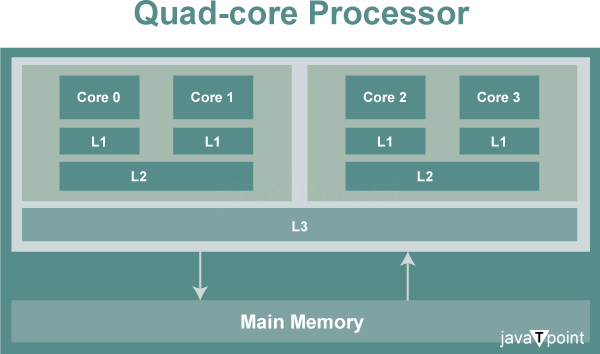Quad-Core ProcessorsIn the fast-paced realm of computer technology, the quad-core processor emerges as a formidable force, boasting four independent processor cores seamlessly integrated onto a single chip. This architectural marvel represents a profound evolution in processing capabilities, promising not only improved performance but also enhanced efficiency and multitasking prowess. In this comprehensive exploration, we delve deep into the world of quad-core processors, uncovering their inner workings, applications, and impact on the modern computing landscape. Quad-Core AdvantageThe notion of multiprocessor architecture, precisely developed to unlock higher processing capabilities, is at the heart of a quad-core processor. The quad-core CPU builds on the foundation built by dual-core processors, which harnesses the power of two processing cores. It accomplishes this by combining two dual-core CPUs into a single processing unit. These two cores interact invisibly via a shared processor cache, resulting in an environment in which each core may execute instructions independently. The advantage of this architecture becomes evident when considering parallel processing. A quad-core processor's defining feature is its ability to execute multiple instructions simultaneously. Each of the four cores operates independently, allowing for the concurrent processing of tasks. This remarkable parallelism empowers the processor to handle resource-intensive applications with ease, offering users a smoother and more responsive computing experience 
Quad-Core ProcessorsQuad-core processors have made major contributions to numerous computer fields, improving performance across a wide range of applications. Because of their adaptability, they may survive in a wide range of computer settings, from laptops and desktops to servers and high-performance workstations. Let's look at how these processors have affected various industries
Evaluating Performance: Cores, Clock Speed, and CacheWhen evaluating the performance of a quad-core CPU, several critical factors must be considered
Multithreading MasteryWhile quad-core CPUs have huge potential for performance improvement, it's crucial to note that not all software can fully use their capabilities. The design and compatibility of the program influence the efficiency of multithreading, a sort of parallelism in which several threads are handled concurrently. Quad-core CPUs can fully benefit heavily threaded applications, while those that aren't may not realize considerable advantages. ConclusionFinally, the quad-core processor represents a huge development in processing technology, providing more power and efficiency to the computer world. The whole potential of these CPUs, however, is fulfilled when they are paired with well-optimized software and a well-balanced computing environment. Quad-core CPUs stay at the forefront of innovation as technology evolves, allowing consumers to embark on quicker, more competent computing experiences. The influence of quad-core processors reverberates throughout the computer environment, from consumer laptops to business servers, revolutionizing the way we work, play, and engage with technology. As we delve deeper into the complexities of these processors, we discover their critical role in building today's and tomorrow's digital worlds.
Next TopicWhat are 2D Barcodes
|
 For Videos Join Our Youtube Channel: Join Now
For Videos Join Our Youtube Channel: Join Now
Feedback
- Send your Feedback to [email protected]
Help Others, Please Share










